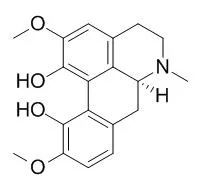| In vivo: |
| Arch Int Pharmacodyn Ther. 1988 Nov-Dec;296:255-81. | | Neuroleptic-like, anticonvulsant and antinociceptive effects of aporphine alkaloids: bulbocapnine, corytuberine, boldine and glaucine.[Pubmed: 2907279] |
METHODS AND RESULTS:
The aporphine alkaloids bulbocapnine, Corytuberine, boldine and glaucine were studied in mice and compared with haloperidol, phenobarbital and morphine. All aporphines inhibited the exploratory rearing activity and elicited palpebral ptosis, catalepsy, hypothermia, and prolonged anesthesia by thiopental. They also reduced nociception (hot plate; phenylquinone-induced writhing) and (except for Corytuberine) were anticonvulsant against harman and picrotoxin, but not against bicuculline and pentetrazol; Corytuberine was proconvulsant. The aporphines (except for Corytuberine) antagonized the apomorphine- and methylphenidate-induced stereotyped gnawing and also the apomorphine-induced climbing activity; Corytuberine was prostereotypic. The antignawing effects (including those of haloperidol) were stronger when the antagonists were administered after the agonists (gnawing full-fletched) rather than before them: this led to the speculation of a metaphilic interaction at central site(s). Clonazepam inhibited the antistereotypic effect (vs apomorphine) more potently with the aporphines than with haloperidol. The antinociceptive effect (writhing) of the aporphines was, in contrast to that of morphine, resistant to both naloxone and yohimbine. The latter applied also to the antilicking action in the hot plate test; the antijumping effect of boldine was (like that of morphine) antagonized by both yohimbine and naloxone, whereas that of Corytuberine was inhibited only by naloxone and that of bulbocapnine preferentially by yohimbine.
METHODS AND RESULTS:
Hence, opioid and adrenergic mechanisms are unequally involved in the antinociceptive effects of the aporphines. The present results also showed that licking and jumping (in the hot plate test) are pharmacologically different phenomena. In low doses, the aporphines and haloperidol antagonized the antinociceptive effect of morphine (hot plate); hence, these drugs may be considered partial agonists or partial antagonists, respectively. |
|






 Cell. 2018 Jan 11;172(1-2):249-261.e12. doi: 10.1016/j.cell.2017.12.019.IF=36.216(2019)
Cell. 2018 Jan 11;172(1-2):249-261.e12. doi: 10.1016/j.cell.2017.12.019.IF=36.216(2019) Cell Metab. 2020 Mar 3;31(3):534-548.e5. doi: 10.1016/j.cmet.2020.01.002.IF=22.415(2019)
Cell Metab. 2020 Mar 3;31(3):534-548.e5. doi: 10.1016/j.cmet.2020.01.002.IF=22.415(2019) Mol Cell. 2017 Nov 16;68(4):673-685.e6. doi: 10.1016/j.molcel.2017.10.022.IF=14.548(2019)
Mol Cell. 2017 Nov 16;68(4):673-685.e6. doi: 10.1016/j.molcel.2017.10.022.IF=14.548(2019)